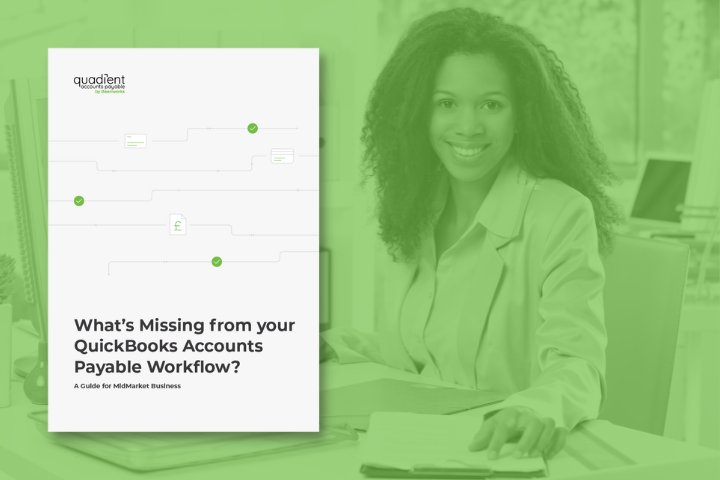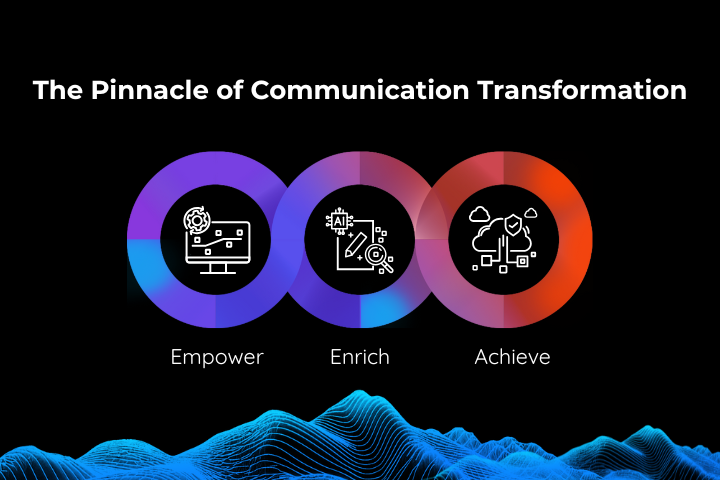
Intuit® QuickBooks® may be best known as an accounting software solution for small businesses, but it’s also the accounting tool of choice for many midmarket businesses and professional accounting firms.
Like most enterprise resource planning (ERP) solutions, QuickBooks is essentially a broad-based tool that increases organisational efficiency at a high-level, by integrating the common functional areas of accounting into a single system.
Third-party applications are an essential part of the QuickBooks experience, as these tools extend and automate critical accounting workflows. Apps are especially relevant to midmarket businesses who use QuickBooks, as these larger businesses deal with higher processing volumes and have a critical need for efficiency and data visibility across the entire organisation.
In particular, the accounts payable (AP) workflow in QuickBooks remains a time-intensive process that relies heavily on data entry and lacks key features essential to midmarket businesses, like a robust document management system and approval routing. Businesses that process hundreds or thousands of invoices each month on QuickBooks can benefit from a closer look at this workflow to discover areas for improvement.
In this whitepaper, we’ll explore how midmarket businesses use QuickBooks, and how accounts payable automation has changed invoice and payments processing for these businesses. By examining the accounts payable workflow in QuickBooks, we’ll also see exactly where the gaps exist and how you can bridge these gaps to increase efficiencies to save you time, reduce errors and elevate your QuickBooks experience to a whole new level.
How Quadient AP will Enhance Your QuickBooks Experience
Quadient AP integration bridges the gap in QuickBooks’s functionality by automating the entire accounts payable process. With Quadient’s advanced technology, businesses can streamline their AP operations, reducing manual tasks and errors, and increasing efficiency and accuracy. This integration allows for a more streamlined workflow, including automated approval of workflows, resulting in cost savings and increased productivity. With Quadient AP integration, businesses can achieve a fully automated AP process that is both efficient and effective.
How the Midmarket is Using QuickBooks
While QuickBooks is best known as a platform for small businesses, midmarket organisations are also on board.
Since its inception, QuickBooks has been marketed primarily to solo entrepreneurs and small businesses—a market that, in the United States, encompasses* approximately 29 million businesses. With more than 80 percent of the small business market share* for financial management software in the United States, QuickBooks has become the go-to solution for the majority of small businesses. But as these businesses grow, many choose to stick with QuickBooks as they progress to the midmarket.
Acknowledging this trend, Intuit released QuickBooks Enterprise in 2002 in order to offer these larger businesses a more robust feature set, including greater historical data capacity, advanced user permissions, and cloud-hosting capabilities. Businesses that cut their teeth on QuickBooks as fledgling operations can choose to graduate to QuickBooks Enterprise, which offers greater scale in a simpler3 package than you’ll find in traditional ERPs, but with an emphasis on ease of use.
QuickBooks Online (QBO) has also become popular among midmarket businesses and accounting firms because, as a cloud-hosted solution, it comes equipped with features that enable these businesses to work remotely from multiple locations and allows simultaneous access for up to 25 users.
Cloud solutions are the way forward for most businesses, regardless of size, and projections show that cloud adoption will only accelerate over the coming years.
£141 billion will be spent globally on cloud services in 2019*
IDC predicts that annual global spending on cloud services will top £141 billion4 in 2019, with Software as a Service (SaaS) products leading the pack as the top cloud computing type. In a recent round-up of predictions for the future of SaaS, accounting was cited5 as a major contender for innovation:
“Intuit is focused on moving their user base to QBO as Xero and QBO battle for market share,” said Catherine Dahl, Quadient AP CEO. “Accountants are smart: once they get the feel of the cloud version of their role, the entire accounting software space will begin a true disruption. Thus far, the innovators in this sector are driving the change. Accounting is a conservative, risk- averse group by nature. They waited while every other sector tested the cloud apps before dipping in.”
In light of the cloud adoption trends, it’s no surprise that some midmarket businesses also choose to switch6 to QBO from a traditional accounting solution. Although the QBO feature set is not as robust as what’s included in the rest of the QuickBooks lineup, these missing pieces can be filled in, and significantly improved, by leveraging third party integrations.
One of the most common processes these businesses upgrade through integrations is accounts payable (AP). While the built-in QuickBooks AP workflow may be adequate for a small business with a low bill volume and a simple corporate structure, the same can’t be said for a large, more complex businesses.
Midmarket Businesses and Accounts Payable
Digitisation and automation are already a big part of how midmarket businesses streamline their processes.
Moving paper-based and offline operations onto networked and cloud-based digital applications is transformative for businesses. These types of changes can have a wide-ranging impact within an organisation, not only cutting operational costs, but also improving customer service levels, shifting corporate culture to empower employees, and facilitating strategic decision-making through better data capture and visibility.
According to a survey* from The National Center for the Middle Market, about 40 percent of funds allocated towards digitisation in U.S. midmarket businesses goes to administrative and back office functions, like accounting and HR processes. Half these digitisation efforts are implemented in order to create efficiencies and to cut costs.
The AP department often has to tackle the most repetitive, manual work in accounting and is rarely seen as a strategic center within the business. Only 15 percent of businesses* see their AP department as a valuable collaborator, and one-third don’t see accounts payable as a strategic operation at all, despite the high amount of data that circulates through the department each month.
The Automated Invoice Workflow
Capture> Review> Code> Approve> Pay
However, automating processes within accounts payable can improve this outlook. Automation will eliminate data entry errors, minimise delays and increase job satisfaction, as AP staff can reallocate their time from mundane manual tasks to higher value activities.
Better yet, AP automation opens up a data gold mine for businesses, which can be leveraged in a number of ways. In a 2016 Ardent Partners report9, there were six main areas impacted by the availability of AP automation data: invoice exception handling, improving collaboration between the finance and procurement departments, forecasting, budgeting and planning, enhancing supplier manager, developing better payment strategies, and understanding cash impact.
For businesses that rely on QuickBooks, the AP workflow has already been digitised—up to a point—but the workflow lacks automation. With QuickBooks, your accounting data is centralised, but without automation, the process of entering that data into the system is time-consuming and prone to error. We’ll take a look now at how to address the most common limitations you’ll encounter in QuickBooks accounts payable.
Common AP Limitations in QuickBooks
Businesses can easily enhance their QuickBooks experience by leveraging AP automation features through a third-party application.
Invoice entry and coding is time consuming
Entering vendor invoices into QuickBooks is essentially a manual process, where you create a new bill entry in QuickBook and fill in all the applicable fields10 yourself by hand: vendor, mailing address, terms, bill date, due date, bill number, and location. There are also fields associated with account details and item details, all of which require your direct action to complete.
For every paper invoice you receive, this means time spent typing all that information into the system. If you’re receiving your invoices through digital means, like email, you’ll still find yourself copy and pasting the data into the system. Small businesses with few invoices might still find this practice manageable, while a nuisance, but for midmarket businesses with hundreds or thousands of invoices to deal with each month, this represents a huge burden of time. Each field entered manually also represents a distinct chance for error.
80% of processing times can be cut by switching to AP automation
Research has shown that AP automation tools can cut processing times* by as much as 80 percent simply by automating the data entry process. First, a digital copy of the invoice is captured by scanning and uploading paper invoices, or sending electronic invoices to a designated email address. The captured invoice pages can then be rearranged, deleted or moved within the AP automation tool.
Next, the data on the invoice is extracted. Many AP automation providers accomplish this through optical character recognition (OCR) technology, which transforms physical or electronic images of text into machine-encoded text. Digital documents, like scanned paper documents and PDF files, are converted into editable and searchable data.
However, as a major caveat, OCR technology accuracy rates vary widely, and the technology in its current iteration is unable to intelligently distinguish between different types of data, so errors are still likely to occur unless human intervention is also used. In short, OCR technology is not yet reliable enough to be used autonomously and successful AP automation systems will have other means of ensuring data entry accuracy.
Many AP automation solution will provide automatic PO-to-invoice matching, eliminating yet another manual task. With a platform like Quadient AP, coding invoices with specific general ledger (GL) information is also simplified thanks to the SmartCoding feature. SmartCoding uses machine learning to automatically adopt the line coding from the last invoice that came from the same supplier. Everything from GL expense line coding to description is carried over.
QuickBooks lacks approval workflows
One of the most useful features of QuickBooks Online is that it can be accessed by users from wherever they happen to be, so long as they have an internet connection and a WiFi enabled device handy. This is of course the beauty of cloud software. But while the platform can be easily accessed, Quickbooks doesn’t include the ability to route invoices for approving.
While users can enter bill details into QuickBooks, there is no built-in method to send the coded invoice to another user (or users) for approval before payment. Although you have the option to add authorised users in QuickBooks, there are no integrated internal control functions for approval limits and user workflow. Instead, companies without AP automation have to resort to the long-held tradition of chasing after signatures in person or through endless, pestering emails.
Approval routing is a standard feature in many AP automation platforms. For example, Quadient AP automatically routes and notifies the correct approvers once an invoice has been coded. Invoices are centralised and always accessible using customised credentials so the right people have the right access. AP automation tools, which are typically cloud-based applications, can similarly be accessed from anywhere and that technology also makes it possible for approvers to be notified, and complete their approvals, from anywhere. Whether an approver is away on a business trip or located in a remote office with an internet connection, they can access the AP automation tool and continue to help move invoices forward
Similarly, AP automation tools that also include a payments workflow will also include payment approval routing, through which payments can be directed to specific approvers, along with backup pages, for verification before the payment is released to the vendor.
Limited payment options
The AP automation process completes its cycle with automated payments. The manual work of payments—getting approval for and then signing and mailing physical checks—can be digitised to save on costs and pay vendors faster and more efficiently. Currently, QuickBooks Online users can either print and mail checks themselves or send Automated Clearing House (ACH) files to their banks. There is no way to directly pay your invoices electronically within QBO, and so it’s necessary to turn to a third-party app.
manual work of payments can be digitised to save time and money.
While Intuit does offer the QuickBooks Bill Pay Service, which requires a version of QuickBooks that supports online banking, this add-on does not actually expand your options. The service simply provides a service that uses ACH processing or MasterCard RPS network to make payments to vendors able (and willing) to accepts payments in this form, and a check printing service for your other vendors. The service is also only able to make payments to companies and individuals in the United States, and payments outside the U.S. are prohibited.
Luckily, your vendor payments options are expanded considerably when you choose to implement an AP automation solution, including: ACH, Electronic Funds Transfer (EFT), wire transfer, automated checks, and virtual credit cards (VCC). As a relatively new form of payment, virtual credit cards in particular are a valuable form of payment because they are typically tied to rebate programs that can earn business a cash percentage back on every payment. The security benefits of virtual credit cards are also well established.
Level up QuickBooks with AP Automation
Quadient AP integrates seamlessly with QuickBooks Online through a direct connection. With just a few clicks of a mouse, you can authorise Quadient AP to connect with a QBO account, after which the data is synced automatically from that point onwards in real time.
If you’re a midmarket organisation with multiple legal entities, you may need to connect your AP automation solution to multiple instances of QuickBooks. In Quadient AP, a connection/ sync button will exist in Quadient AP for each QuickBooks company or legal entity you want to connect.
Once Quadient AP and your legal entities are connected to each other, the data transfer happens automatically and instantly. From each QuickBooks company/ legal entity, we receive the following information: Vendor List, Account List, Class List, Items List, and Customer/Job List. Payments made on invoices are also received, and we attach this information to Invoices in Quadient AP. From Quadient AP, we send all approved AP Transactions from Quadient AP into QuickBooks as “Bills” which are then ready for you to manage inside of QuickBooks Online.
We also offer integration with QuickBooks Pro, Premier and Enterprise installations.
*Download the What’s Missing from your QuickBooks Accounts Payable Workflow? whitepaper now to learn more







